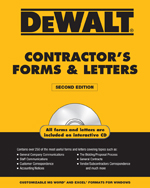A common remark I hear from owners is, “My managers don’t make enough money to buy the company!” I get it.
The most likely exit for contracting companies is a management buyout as there are very few successful sales to competitors/consolidators.
MBOs tend to be the most common transfer methods due to the inherent nature of construction companies. The lack of recurring revenue and connection to cyclic economic conditions make construction companies a risky investment by outsiders (consolidators or private equity).
This means a wall and ceiling contractor’s most probable opportunity for monetizing the business will come from senior managers and family.
The largest obstacle in executing an MBO is that managers often do not have the financial ability to pay for the business. This requires the business owner to structure a plan that will allow the business to pay for the transition. Therefore, careful consideration should be given to the many tools available to help achieve the best tax yield for the sale while minimizing the financial risk of getting paid for the business.
Another major obstacle for the seller of an MBO is the financial risk. The risk of an MBO is the owner not being paid. The buying senior management team performance is tied to the cash flow that will pay you. This is why succession is a key factor in an MBO.
The good news is that an MBO exit has a lot of flexibility and, if properly structured, can have significant tax advantages. In certain situations, a properly structured MBO will reap a better bottom line result than an outside sale because of the tax savings. Remember, it is not how much you get, but how much you keep.
Utilizing the ideal balance and coordination of various tools should create a result of dollar maximization with risk minimization.
Key Considerations
- Know the value of your company and exit without being clobbered by taxes.
- Sales price can be negotiated as opposed to a computed amount in accordance with IRS ruling 59-60.
- Understand the various tax liabilities (which can exceed 55 percent) with bottom line after tax illustrations of each path.
- Because these transactions are structured with financing over time it is critical that you clearly understand risk-management strategies to protect what you have built.
- Prepare the managers for succession ASAP because it takes time.
- Future cash flow pays for everything, and your managers will drive the profits.
- Time is your best friend, so start early and implement slowly.
Below are several business and key risk-management concepts for your exit via a management buyout.
Business
Visualize Your Financial Future: Owners cannot commit to retirement until they can visualize their financial future with an exit plan. The plan calculates the value of the company, before and after taxes, so the proceeds can create the income to maintain the owner’s present lifestyle in retirement. Only then is the owner motivated to pick and lead the team into the MBO and succession process.
Outside Savings: While the owner is still in control, he or she should contribute as much as possible to savings and retirement accounts. There are several internal and external (of the business) programs that are very tax-efficient for the company and owner. This will take the pressure off the price of the company during the sale. These strategies should be outlined in the exit plan.
Benefits: The owner can still receive benefits during the sale and have those benefits phased out over time depending on the sales agreement. This is all determined in the exit plan and understood before approaching management.
Win-Win: An MBO is a win-win for the buyer (management) and seller (owner/s). Management has the opportunity to build significant personal wealth, and the owner benefits by cashing in on the investment built in the company. Sellers also leave a legacy with trusted stewards who bring a new energy.
The Company Pays for Everything: I remember in the late 1980s when our company’s owner asked me if I would like to buy the company and I said, “Dick, I cannot afford to buy the company.” He said, “Kevin, just keep the company growing and profitable, and the company will buy my stock and give it to you.” In other words, if you generate profits, the company will pay for everything.
Ownership: Multiple-ownership has become an increasing trend in the industry. A study conducted by FMI on the distribution of ownership in construction companies illustrates the following composition of multiple owners:
67 percent: multiple owners with one shareholder in control;
27 percent: multiple owners with
no control;
6 percent: one owner with all the stock.
Shareholders: The new shareholders must understand that their stock ownership does not necessarily make them the boss. There can only be one boss/authority. Yes, you are a senior manager and work collectively for the company’s success, but you are an employee/associate first and a shareholder second. As a shareholder, you benefit directly from the success of the company.
Risk Management
Risk: With an MBO there is a risk of the owner/s not being paid by the managers. That is why it is critical to find the right person/s who have demonstrated the broad capability to run the company and who show the leadership ability to take the company to the next level.
Buy-sell Agreement: The Shareholder Agreement must address the four “Ds” of death, disability, divorce and departure and how they trigger the buy-sell. The agreement should leave little ambiguity for the reader. Remember, in most cases, the document will be referred to by the existing owners and the deceased shareholders spouse … and legal counsel. The agreement should consider valuation formulas, funding and transfer of ownership.
The Golden Egg: The company is the goose that lays the golden eggs. The company must remain fiscally healthy during the buyout and endure the economic cycles. During our buyout we kept the payments flexible even though I had annual notes from the buyers. Why? Because the company came first. We were paid out early, even though we reduced payments through 2008, and overpaid during the great years.
Financing: The sale is many times funded by seller financing, the redemption of the owner’s share over time or by outside financing via a leveraged buyout.
Financial Partners: Be transparent with your key financial partners, including your bank and bonding company, as they should be kept in the loop with your transition plan. The company still needs to keep healthy financial ratios and the necessary working capital, but it will look different as money is transferred to the owner in the buyout. Your financial partners will understand and benefit from a well-thought out transition plan.
Personal Guarantees: Get the new management and especially the comptroller engaged with your financial partners. Banks and bonding companies depend on the owner’s personal guarantees, which will have to be transferred to the new owners near the end of the buyout.
Character Matters: The company associates are your key asset. Promote the best people in the right chairs for the company to perform. The empty chair must be replaced with a person of integrity. Leaders put the company, customers and associates first … not themselves.
Succession: Succession is the key as the owner is being paid by the management’s performance. First the managers need to get to the next stage by growing and performing as champions. During this time, they must begin to think like owners and always put the company first. They then will move into leadership, deal with their blind spots, and put their associates and teammates first.
Continuous Process: Succession takes time. It is a continuous process, not a single event. The process is about the development of talent and not the typical replacement of talent. Your best players are developed in your internal culture, and owners must provide the curriculum, training and leadership development.
In conclusion, the process of exiting your business should not be taken lightly as there is much at stake. For many owners, the business can be their largest single asset (more than 70 percent) and the primary source of retirement funds. With so many moving parts and the government as the greatest source of sales price erosion, a carefully designed exit plan should help overcome many of the barriers that owners will confront. In this process time can be your best friend, so start early and implement slowly.





Report Abusive Comment